
The Rue de la Paix is a fashionable shopping street in the centre of Paris. Located in the 2nd arrondissement, running north from the Place Vendôme and ending at the Opéra Garnier, it is best known for its jewellers, such as the shop opened by Cartier in 1898. Charles Frederick Worth was the first to open a couture house in the Rue de la Paix. Many buildings on the street are inspired in design by the hôtels particuliers of Place Vendôme.

This "quartier" of Paris got its name from the rue de la Chaussée-d'Antin in the 9th arrondissement of Paris. It runs north-northwest from the Boulevard des Italiens to the Église de la Sainte-Trinité.

The Rue du Bac is a street in the 7th arrondissement of Paris. The street, which is 1,150 m long, begins at the junction of the quais Voltaire and Anatole-France and ends at the Rue de Sèvres.

Henri Sauvage was a French architect and designer in the early 20th century. He was one of the most important architects in the French Art Nouveau movement, Art Deco, and the beginning of architectural modernism. He was also a pioneer in the construction of public housing buildings in Paris. His major works include the art nouveau Villa Majorelle in Nancy, France and the art-deco building of the La Samaritaine department store in Paris.

The Rue de la Victoire is a street in the 9th arrondissement of Paris.

The Hôtel Thellusson was a luxurious hôtel particulier located in Paris, France, built in 1778 by Claude-Nicolas Ledoux for Marie-Jeanne Girardot de Vermenoux (1736–1781), the widow of Georges-Tobie de Thellusson, a Genevan banker.
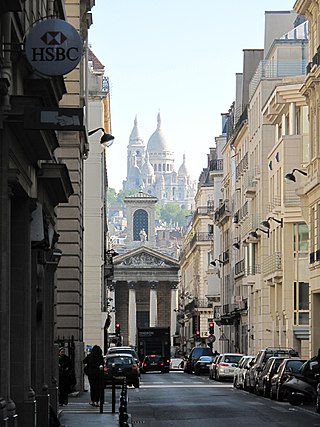
Rue Laffitte is a street in the 9th arrondissement of Paris, located near the Metro stations Richelieu - Drouot and Notre-Dame-de-Lorette.
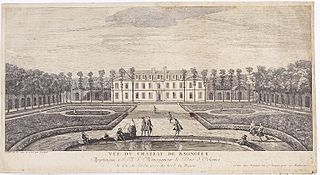
The Château de Bagnolet was a château situated in the Paris suburb of Bagnolet, France, 5.2 km from the center of the capital. The property was part of the biens de la Maison d'Orléans, private property of the House of Orléans from 1719 till 1769.

The Rue du Bœuf is a 188-metre cobbled pedestrian street of the Vieux Lyon quarter, located in the 5th arrondissement of Lyon. Very representative of the Renaissance architecture of the neighborhood, it is lined only with old houses from the 16th or 17th century. The street connects the rue de Gadagne which it continues after the Place du Petit Collège and the intersection of the rue du Chemin Neuf, the rue de la Bombarde and the rue Tramassac which prolongs it. The street belongs to the zone classified as World Heritage Site by UNESCO.

The Rue Saint-Lazare is a street in the 8th and 9th arrondissements of Paris, France. It starts at 9 Rue Bourdaloue and 1 Rue Notre-Dame-de-Lorette, and ends at Place Gabriel-Péri and Rue de Rome.
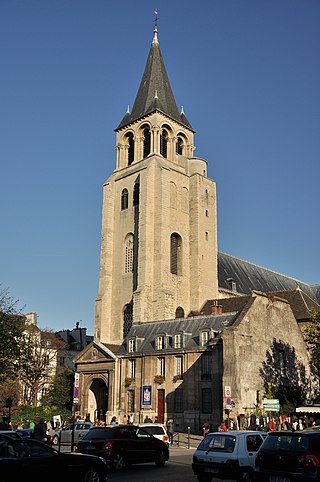
The city of Paris has notable examples of architecture from the Middle Ages to the 21st century. It was the birthplace of the Gothic style, and has important monuments of the French Renaissance, Classical revival, the Flamboyant style of the reign of Napoleon III, the Belle Époque, and the Art Nouveau style. The great Exposition Universelle (1889) and 1900 added Paris landmarks, including the Eiffel Tower and Grand Palais. In the 20th century, the Art Deco style of architecture first appeared in Paris, and Paris architects also influenced the postmodern architecture of the second half of the century.

Louis Bernard Bonnier was a French architect known for his work as an urban planner for the city of Paris. He was instrumental in loosening the restrictions on the appearance of buildings in Paris, which resulted in the blossoming of Art Nouveau buildings. He designed many significant buildings himself, including private villas, public housing and railway buildings. In all his work he was true to the rationalist principles of Art Nouveau.
The concours de façades de la ville de Paris was an architecture competition organized by the city of Paris at the very end of the 19th century and beginning of the 20th century.
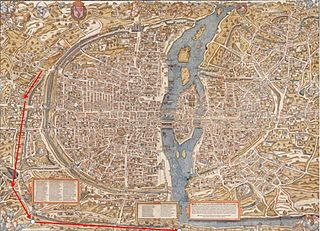
The Menilmontant brook is an old and small river in Paris.
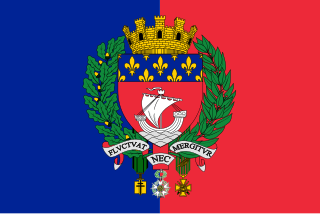
The following outline is provided as an overview of and topical guide to Paris:
Christophe Gamard, Gamar or Gamart, was a 17th-century French architect, who worked in Paris and died there in 1649.

The Rue Crémieux is a one-block pedestrian street in the 12th arrondissement of Paris, originally built as workers' housing. The street has been widely recommended to tourists for its quaint painted housefronts, and has become a popular destination for filming and for social media photos.
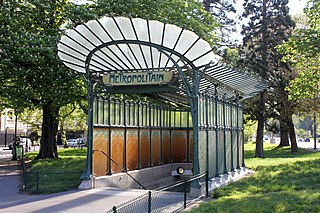
The Art Nouveau movement of architecture and design flourished in Paris from about 1895 to 1914, reaching its high point at the 1900 Paris International Exposition. with the Art Nouveau metro stations designed by Hector Guimard. It was characterized by a rejection of historicism and traditional architectural forms, and a flamboyant use of floral and vegetal designs, sinuous curving lines such as the whiplash line, and asymmetry. It was most prominent in architecture, appearing in department stores, apartment buildings, and churches; and in the decorative arts, particularly glassware, furniture, and jewelry. Besides Guimard, major artists included René Lalique in glassware, Louis Majorelle in furniture, and Alphonse Mucha in graphic arts, It spread quickly to other countries, but lost favor after 1910 and came to an end with the First World War.

Hôtel de Guénégaud or Hôtel de Guénégaud-des-Brosses is a 17th-century hôtel particulier, or large townhouse, in Paris.

The Rue de Lille is a street in the 7th arrondissement of Paris, France, in the upscale Saint-Thomas-d'Aquin and Invalides quarters.





















